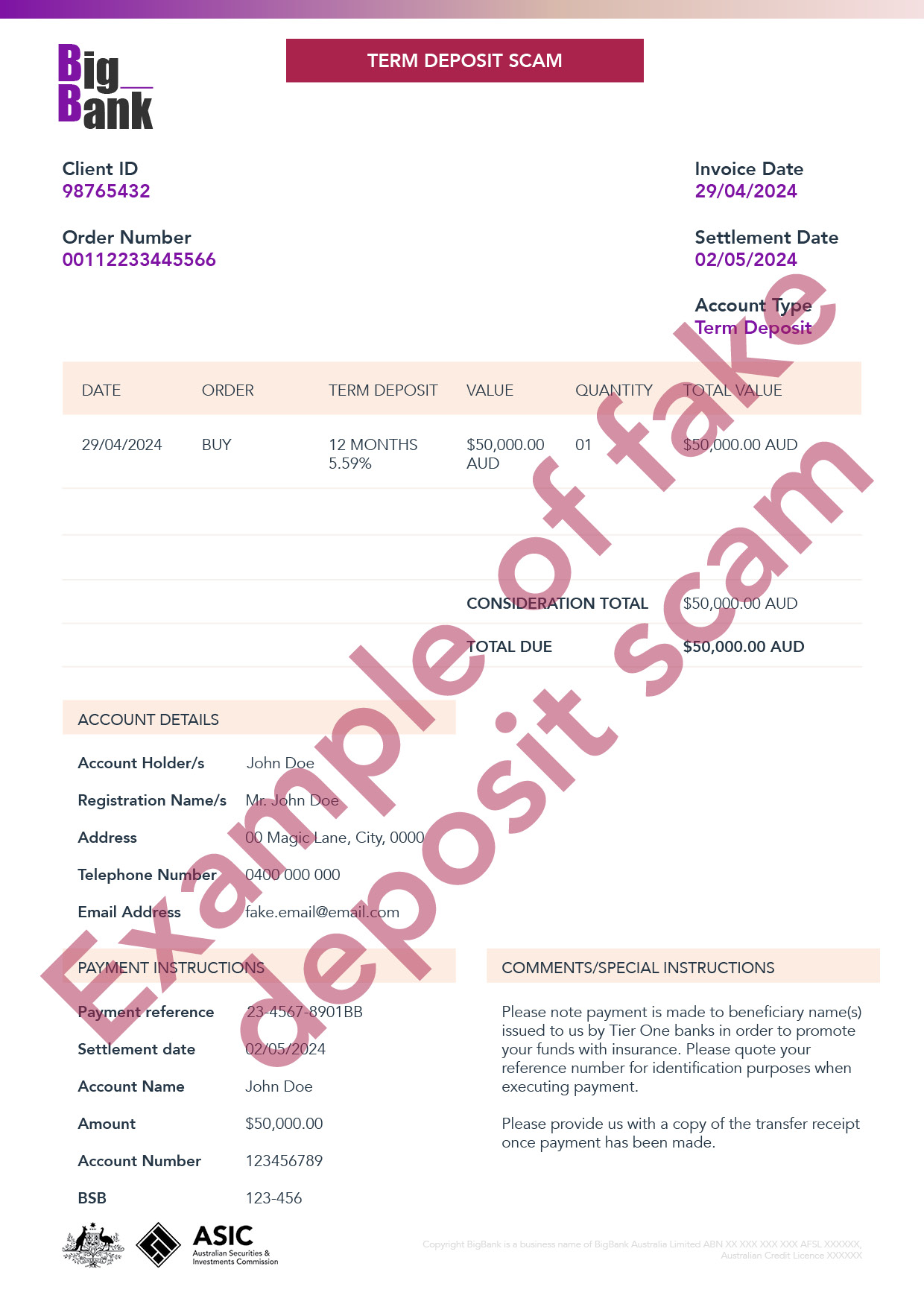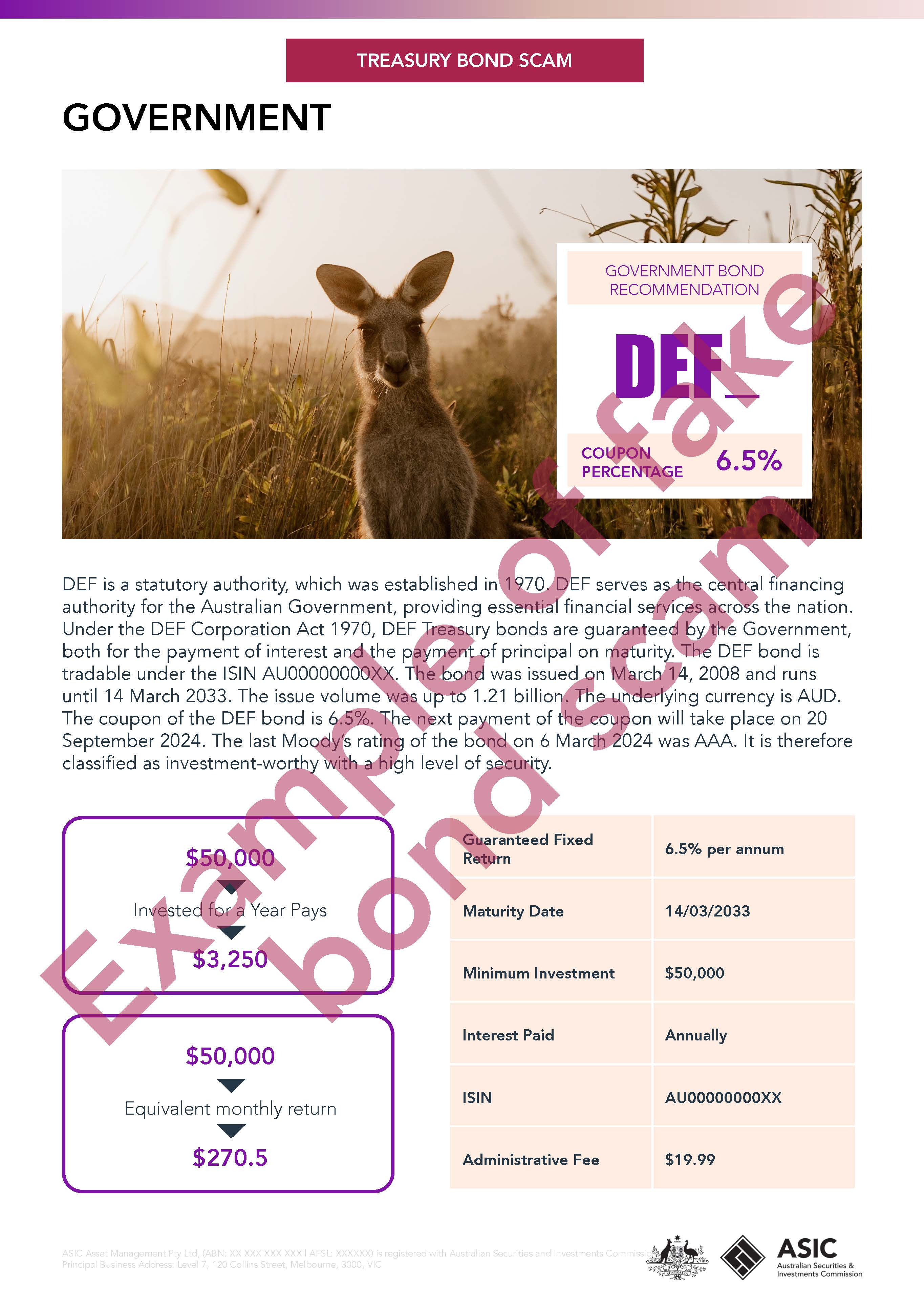Key points
- ASIC is alerting consumers to new ways scammers are offering fake bond and term deposit scams. Scammers are increasingly impersonating legitimate financial services businesses which often don't have a website or digital footprint. The scammers are also creating fake reviews.
- Scammers mirror the real business addresses, Australian business numbers (ABNs) and financial services licence numbers in their advertising and communications.
- ASIC encourages consumers to be alert to investment scams that set up bank accounts in the consumer's name or request funds be transferred to a third-party account that is not in the name of the financial services business or held by the bank providing the service.
ASIC is warning consumers about an increase in the sophistication of fake bond and term deposit scams where scammers are impersonating little-known legitimate financial services businesses, often those without a website or digital footprint.
Scammers are mirroring real businesses' disclosure documents, addresses, International Securities Identification Numbers (ISINs), Australian business numbers (ABNs) and Australian financial services (AFS) license numbers, as well as imitating investment maturity dates, coupons and credit ratings.
Scammers also use online advertisements and social media to promote fake bond and term deposit investment offers in well-known companies. The ads lead consumers to an online enquiry form which scammers use to collect personal information, such as their name, email address, and telephone number.
Consumers targeted by these scams are provided with fake investment materials and disclosure documents. The scammers will sound professional, knowledgeable and be personable, and may not rush consumers to make a decision. Often, the investment return being advertised by scammers will sound reasonable (as opposed to "too good to be true" scams).
The scammer will ask the consumer to return a completed application form and personal identity documents. They will then ask the consumer to transfer funds into a bank account. This can appear in the name of the investment or one that is in the consumer's name. However, it is actually a bank account associated with the scammer. Often this account will be held by a legitimate bank not offering the bond or term deposit.
What to look out for
It can be very hard to identify fake bond and term deposit investment offers so it's important to be careful when considering making investments.
Common signs of a fake bond and term deposit scam:
- Use of certain words and phrases. Scam offers typically use the phrases "guaranteed", "secure" and "free" - phrases ASIC warns legitimate financial services businesses against misusing.
- Impersonation of financial services businesses that don't have a digital footprint. Scammers often use the details of legitimate financial services businesses who do not have a website, social media account or other digital channels. They do this to limit consumers' ability to conduct internet searches or other research on the company as there is no 'real' website or internet presence to compare the scammers website or emails against.
- 'Issuing' bonds or term deposits in other large companies. The fake bonds and term deposits offered by scammers are in well-known companies, such as banks and ASX-listed companies. Large companies can issue bonds or term deposits themselves and don't require other companies to 'issue' bonds on their behalf. If a business is claiming to issue Treasury or government bonds, then it is a scam. Check out Moneysmart's imposter bond investment scams to learn more about fake 'low-risk' investment products, like bonds or fixed term deposits.
- Fake online reviews. Be wary of reviews on content-generating websites that allow companies to pay to create and/or publish their news and reviews. These websites produce general content and may not be focused on investments. Usually the content created presents only positive aspects of the investment and doesn't make comparisons to other investments.
- Fake investment documentation. False materials provided by scammers can contain:
- Stolen business details including the Australian Business Number (ABN), Australian financial services (AFS) licence number and business address of a legitimate financial services business that is being impersonated.
- Imitated details of legitimate bonds or high-interest deposits such as a real maturity date, coupon, credit rating, and ISIN number of legitimate bonds.
- Claims that bonds can be cancelled and that the funds used for the bond can be returned after the first 90 days from the date of investment. It can also falsely claim that the investment scam is covered by the Australian Government deposit guarantee scheme. Check APRA's website for information for firm eligibility under the scheme. Scammers may include these details to create a false sense of security.
- Use of Government logos. In some cases, the fake documentation will include the improper use of government logos. Financial services businesses are not allowed to use the Australian coat of arms or any Government logo, such as ASIC, APRA, or AUSTRAC, to promote financial products.
- Fake Australian financial services (AFS) licence. The scammers may quote Australian financial services numbers that do not exist. Make sure to always check the licence details via ASIC Connect's Professional Registers.
- Requests for the consumer's banking details and transfer of funds. The scammers may ask consumers to send funds to a bank account in the name of an individual. They may claim the account is in the consumer's name because it is a 'client segregated account'. Legitimate financial services businesses are required to hold client money for investments in a trust account, client segregated account or cash management trust held in the name of the licensee.
- Require funds be transferred to a third-party account. The scammers may ask consumers to send funds to a third-party account. Bank account details for receiving consumer money should always be in the name of the relevant financial services business. Confirm bank account details by checking the BSB on the Australian Payments Network or by independently contacting the bank directly using the details on AFCA's website.
- Requests for account details for 'interest' payments. Once the consumer has transferred money for the investment, the scammer may confirm the bank account details where 'interest' payments will be made, like legitimate financial services businesses may do. However, be aware! These banking details may be used for reversal repayment scams in the future.
- Unexpected contact. Treat phone calls, emails, social media messages, discussion forums or SMSs from people claiming to be from a financial services business that you haven't contacted before as suspicious. Be extra careful if you have provided your contact details to a comparison website as you may receive calls from scammers impersonating financial services businesses.
Learn more about how scammers have previously offered fake bond and term deposit products. See ASIC warnings for bond and high-interest deposit scams: imposter bonds scams, QANTAS bonds, Telstra bonds, Treasury Bonds, High Interest Deposits, green bonds, and Moneysmart's imposter bond scams. Read a case study example of how to avoid an imposter bond scam.
Learn how to buy and sell bonds by visiting ASIC's Moneysmart bonds and term deposits.
Examples of bond and term deposit scams
Protect yourself
Before investing, it's important to slow down and do some checks.
STOP
- Don't give personal information or act on investment advice you have come across on a suspicious looking website or social media post.
- If you have any doubts, stop communicating with them.
- Be wary of fake online reviews, including on social media.
- If there are government logos promoting a financial product, then it is likely a scam.
THINK
- Ask yourself if you really know who you are communicating with? Independently verify who you are dealing with.
- Look up ASIC's Moneysmart investor alert list to help keep informed about investments that could be fraudulent, a scam or unlicensed.
- Check AFCA's website for contact details of financial services businesses and use these contact details to reach out to the financial services business directly and check the legitimacy of the offer.
- Independently verify claims, such as if the bond is covered by the Australian Government deposit guarantee scheme.
- Check the website of any financial services businesses that you have been told are involved in the investment opportunity to see if they have warned the public on their website about recent scams.
- Do your own research on how to invest in bonds and term deposits and their characteristics by reviewing material on state and federal government websites. Follow the tips on Moneysmart's check before you invest page.
- Consider discussing the investment with your current financial institution or an independently sourced financial advisor, especially if the proposed investment is large.
- Don't rush to act. Take the time to ask yourself:
- why does the investment documents have a government agency logo on it, for example, an ASIC or APRA logo
- why have you been contacted
- why isn't the offer available online and needs to be emailed to you
- why does the entity not have a digital footprint
- why is the destination bank account for transfer of investment funds in your name
- why is the destination bank account held with another bank when the entity you are investing with could offer these banking services
- why are they issuing bonds or term deposits in other very large companies when the companies could do that themselves
- how does the interest rate offered compare to others in the market
- does the financial services business' contact details match those on AFCA's website
- have you visited Australian government websites on bonds and term deposits, such as Australian Office of Financial Management for treasury bonds or Queensland Treasury's QTC bonds, and checked the way you are looking to invest matches how the government states you can invest in these products
- does the Australian financial services licence number exist on ASIC's register
- have I checked for scam warnings or conducted any other independent searches and enquiries on the offer.
PROTECT
- Act quickly if something feels wrong. If you have shared financial information or transferred money, contact your bank immediately.
- Help others by reporting to Scamwatch.
- Directly contact the company the investment claims to be from using the phone number or email address on their main public website which consumers can find by doing an independent internet search.
Think you have been scammed?
If you think you've been scammed, take these steps fast:
- Do not send any more money. Block all contact from the scammer.
- Report it to your financial institution. If you are not happy with your financial institution's response, you can make a complaint to the Australian Financial Complaints Authority.
- Contact IDCARE, a free government-funded service, which can help to develop a specific response plan if your identity has been compromised. IDCARE will never contact you out of the blue.
- Be wary of follow-up scams promising to help get your money back.
- Report it to Scamwatch to help stop the scammer.
- Warn your family and friends about the scam.
Go to what to do if you've been scammed for more detailed steps.










